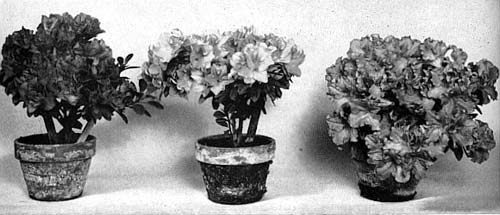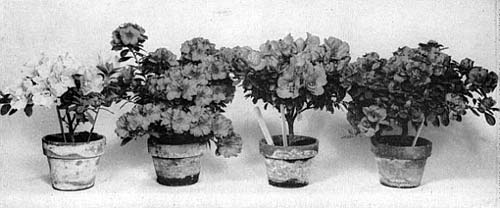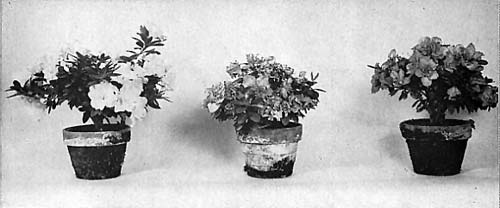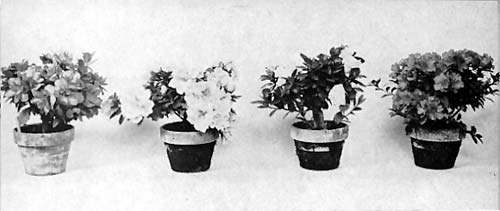QBARS - v16n1 Year-Around Azaleas
Year-Around Azaleas
Richard S. Lindstrom
Department of Horticulture, Michigan State University
The popularity of the azalea as a florist potted plant has increased tremendously in the past 10 years. Due to its range of colors and its keeping quality, the sale of this plant has made large inroads in the sale of hydrangeas. The azalea is even preferred over the lily occasionally, though the lily is still traditionally accepted as symbolic of the Easter season.
Because of this increasing popularity several greenhouse concerns have recently begun producing the azalea the year-around. Using very precise growing practices, they schedule production by propagating every two weeks throughout the year.
Such a propagation schedule is not considered feasible yet for the smaller producers of azaleas. Taking cuttings every two weeks or even once a month is a schedule that only the large specialist is inclined to practice.
For the Michigan grower, it would seem practical to grow the summer azalea production in one, two, or possibly three different crops. By manipulating the duration and temperatures of the growing, pre-cooling, and forcing periods, the grower is able to have azaleas from Easter until Thanksgiving.
Thus only the grower who can obtain the use of refrigerated storages for pre-cooling purposes can use the following practices. Pre-cooling cannot be done in a cool greenhouse because plants have to be pre-cooled during late spring through the late summer period when a 50° F. greenhouse is impossible to find.
Materials and Methods:
Year-around azalea trials were conducted at the Plant Science Greenhouses of Michigan State University for flowering during the summer of 1959 (Trial 1) and during the summer of 1960 (Trial 2) to study the feasibility and production practices outlined above. The growing practices used for year-around production can be divided into three periods: 1) growing on period (from cut back to storage), 2) pre-cooling period and 3) forcing period (from the time the plant leaves the storage until flowering.)
Trial 1:
Large 6-inch azalea plants were obtained through the courtesy of Dinser Bros. Greenhouses. 1 On December 10, 1959, plants were cut back so that only dormant vegetative buds were present. The plants were then grown in a 60° F. (night temperature) greenhouse until April 23, 1959, a period of 19 weeks. At this time they were placed in a refrigerated cooler (35° F.) and held there until June 4, 1959 (6 week pre-cooling period). The plants were then removed from the refrigerated storage into a 60° F. greenhouse where they were forced. In this trial experiment, it was to be determined whether plants could be grown during low light intensity periods and using the above growing practices, develop salable azalea plants. Data to be collected to determine the salability of the plant would include the number of weeks to flower from the beginning of the forcing period and the uniformity of flowering.
Trial 2:
Azalea plants for the 1960 trials were obtained through the courtesy of The Roy F. Wilcox and Co. 2 Four-inch potted plants were used in order that a larger number of plants could be placed in a limited amount of refrigerated storage space. In these trials. six plants each of 25 varieties were used. Three plants of each variety were grown in a 70° F. (night temperature) greenhouse and three plants of each variety were grown in a 60° F. (night temperature) greenhouse. Plants were allowed to become established and on February 8, 1960, part of the plants were cut back on to the new growth while part of the plants were cut back on growth of a season before the new growth.
In order to give the reader some indication of the development of the flower buds in the 1960 trials. Tables 2 and 3 present the size of the reproductive buds just prior to placing the plants in the refrigerated storage. The minimum and maximum sized flower buds on one plant from each variety were measured.
To establish some flowering date that would be satisfactory to all, it is suggested that the day that true flower color was first visible should be used. Using some term such as "full bloom" might mean something different to any number of individuals.
Due to temperature and variety differences, here were two different times in which plants were placed in the refrigerated storages; these dates were May 3 and June 6, 1960. Plants placed in the refrigerated storages on May 3, 1960, were forced in a 60° F. greenhouse starting June 21, 1960 and plants pre-cooled beginning on June 6, 1960, were placed in a 60° F. greenhouse on July 20, 1960.

|
|
Fig. 6. Grown at 70 degrees Fahrenheit
R. 'Memoria Sander', 'Dorothy Gish' and 'Red Wing' Michigan State University photo |

|
|
Fig. 7. Grown at 70 degrees Fahrenheit
R. 'Eric Schaeme', 'Hexe', 'Chimes' and 'Abundant' Michigan State University photo |

|
|
Fig. 8. Grown at 60 Degrees Fahrenheit
R. 'Alaska', 'Weinachten', and 'Mme. Petrick' Michigan State University photo |

|
|
Fig. 9. Grown at 60 Degrees Fahrenheit
R. 'Eclaireur', 'Gorgeous', 'Perle de Swynaerde' and 'Hexe' Michigan State University photo |
Results
Trial 1:
The response of the plants to the cultural practices outlined is illustrated (Table 1). The author believed from the trial completed in August, 1959, that four varieties were considered satisfactory for a program of this nature. These varieties were Alaska, Coral Bells, Pericat Deep Pink and Red Wing.
Trial 2:
The performance of the plants is described in Tables 2 and 3. This trial indicated that cutting back on new growth or on growth of a season before the new growth made no difference in the development of the plant.
There was an indication by measuring the size of the reproductive buds on the same varieties grown at 60 and 70° F. that comparable bud development was present when the plants were placed in the refrigerated storage.
The azaleas grown at 70° F. developed flowering buds much faster than comparable plants grown at 60° F. It was the opinion of the author that on visual examination only, many of these varieties grown at 70° F. could have been placed into the refrigerated storage much sooner than the 12 weeks from cut back to placing them in storage. As an example, the variety Alaska, based on the size of the flowering bud, could have been placed in the refrigerated storage eight to ten weeks after cut back rather than the 12 weeks of growing time that was allowed. This does not necessarily mean that the bud was physiologically ready for the storage, and only further tests can answer this question.
Not only did plants develop faster during the growing period at 70° F. but flowering was improved in at least six varieties. There undoubtedly are many physiological and environmental conditions that are responsible for this difference: one environmental reason was that these plants were not forced at the same time and environmental conditions no doubt were different.
Due to the added expense when growing at 70° F. rather than at 60° F. in the winter, most growers are interested in those varieties that will do well at the lower temperature. Because the same variety was not flowering at the same time when grown at the two different temperatures, it was very difficult to compare number of flowers produced when grown at 70° F. and at 60° F. Kiplinger's (1) work would suggest that a greater bud count would be present when grown at 65° F. or above. Referring to Tables 2 and 3, there are varieties (Example: 'Abundunt', 'Eric Schaeme', 'Gorgeous' and 'Madonna') which definitely did much better at 70° F. than at 60° F. The reason for the poor showing of the above varieties at 60° F. was either uneven or very slow flowering; this definitely was not the case of the same varieties grown at 70° F. Undoubtedly in studying a large number of varieties there would be a demarcation line somewhat above or below 65° F. depending upon variety. Photographs (Figs. 1 and 2) indicate that there are certain varieties which did very well at both 60° and 70° F. (Examples: 'Dorothy Gish', 'Eclaireur', 'Hexe', 'Mem. Sander' and 'Weinachten').
| TABLE 1. Trial 1-Year-Around Azalea Flowering. Azalea plants were cut back on December 10, 1958, and placed in a refrigerated storage at 35° F. on April 23, 1959. Plants were placed in a 60° F. greenhouse on June 4, 1959. | ||
| Variety | First Color | Remarks |
| 'Alaska' | 6-26 | Flowering uniform - One of the better varieties for this program. |
| 'Alice Mueller' | 7-17 | Very uneven flowering-This variety unsatisfactory. |
| 'Coral Bells' | 7-1 | Flowering is excellent and growth heavy. |
| 'Cottage Garden' | 7-5 | Flowering uneven to some degree. Try this one again. |
| 'Emil de Koninck' | 7-15 | Very uneven flowering - Do not recommend |
| 'Pericat Deep Pink' | 6-22 | One of best flowering varieties. - Uniform flowering. |
| 'Red Wing' | 7-7 | Uniform and heavy flowering. |
| 'Rhapsody' | 7-22 | Very uneven flowering. |
| 'Pres. Roosevelt' | 7-27 | Very uneven flowering. |
| 'Sweetheart Supreme' | 8-10 | Very uneven flowering. |
| TABLE 2. Trial 2-Year-Around Azalea Flowering. Azalea plants were cut back on February 8, 1960, and placed in a greenhouse at 60° F. (night temperature). Plants were placed in refrigerated storages (35° F.) on June 6, 1960, and remained there until July 20, 1960. Plants were then forced in a 60° F. (night temperature) greenhouse. | |||||
| Variety |
Growing
temp (F.) |
Pre-cooling dates
1960 |
Flower-bud
size (mm) |
First
color 1960 |
Remarks |
| 'Abundant' | 60 | 6-6/7-20 | 3.2-5.0 | 8-17 | o |
| 'Alaska' | 60 | 6-6/7-20 | 3.2-3.8 | 8-16 | xxx |
| 'Albert Eliz.' | 60 | 6-6/7-20 | 2.9-3.6 | 8-18 | x |
| 'Alfred Sanders' | 60 | 6-6/7-20 | 2.7-3.2 | 8-24 | x |
| 'Chimes' | 60 | 6-6/7-20 | 2.3-4.5 | 8-11 | xxx |
| 'Dor. Gish' | 60 | 6-6/7-20 | 3.0-3.9 | 8-22 | xxx |
| 'Early Wonder' | 60 | 6-6/7-20 | 2.3-3.0 | 8-28 | o |
| 'Eclaireur' | 60 | 6-6/7-20 | 3.2-5.4 | 8-8 | xxx |
| 'Emp. of India' | 60 | 6-6/7-20 | 2.8-3.5 | o | |
| 'Eric Schaeme' | 60 | 6-6/7-20 | 3.0-4.2 | 9-6 | x |
| 'Fantasy' | 60 | 6-6/7-20 | 2.3-3.8 | 9-9 | o |
| 'Gorgeous' | 60 | 6-6/7-20 | 2.2-4.3 | 8-22 | x |
| 'Hexe' | 60 | 6-6/7-20 | 2.8-3.3 | 8-25 | xx |
| 'Jean Haerens' | 60 | 6-6/7-20 | 2.7-3.6 | 9-2 | x |
| 'Lentengroot' | 60 | 6-6/7-20 | 3.2-5.0 | 9-6 | o |
| 'Madonna' | 60 | 6-6/7-20 | 2.8-3.8 | 9-20 | |
| 'Mad. Petrick' | 60 | 6-6/7-20 | 2.2-2.4 | 8.5 | xx |
| 'Mem. John Haerens' | 60 | 6-6/7-20 | 3.5-3.9 | 10-7 | o |
| 'Mem. Sander' | 60 | 6-6/7-20 | 3.0-4.5 | 7-24 | xxx |
| 'Perle de Swynaerde' | 60 | 6-6/7-20 | 3.0-3.4 | 8-5 | x |
| Pink Pearl' | 60 | 6-6/7-20 | 2.5-3.5 | 8-24 | x |
| 'Red Wing' | 60 | 6-6/7-20 | 2.5-3.2 | 8-17 | xxx |
| 'Sweetheart Supreme' | 60 | 6-6/7-20 | 3.1-3.8 | x | |
| 'Vervaeneana' | 60 | 6-6/7-20 | 3.5-3.7 | 9-17 | xx |
| 'Weinachten' | 60 | 6-6/7-20 | 3.0-5.5 | 7-20 | xxx |
| xxx outstanding flowering | |||||
| xx good flowering | |||||
| x fair flowering | |||||
| o poor flowering | |||||
| TABLE 3. Trial 3-Year-Around Flowering. Azalea plants were cut back on February 8, 1960, and placed in a greenhouse at 70° F. (night temperature). Plants were placed in refrigerated storages (35° F.) on May 3 and June 6, 1960, and remained there until June 21 and July 20, 1960, respectively. Plants were then forced in a 60° F. greenhouse. | |||||
| Variety |
Growing
temp. (F) |
Pre-cooling dates
1960 |
Flower-bud size
(mm) |
First color
1960 |
Remarks |
| 'Abundant' | 70 | 5-3/6-21 | 4.4-5.5 | 7-21 | xxx |
| 'Alaska' | 70 | 5-3/6-21 | 2.8-4-6 | 7-16 | xxx |
| 'Albert Eliz.' | 70 | 5-3/6-21 | 2.6-3.2 | 7-14 | xx |
| 'Alfred Sanders' | 70 | 5-3/6-21 | 3.8-4.0 | 7-15 | xx |
| 'Chimes' | 70 | 5-3/6-21 | 3.2-4-5 | 7-25 | xx |
| 'Dor. Gish' | 70 | 5-3/6-21 | 3.8-4.0 | 7-19 | xxx |
| 'Early Wonder' | 70 | 5-3/6-21 | 3.0-3.6 | 7-21 | o |
| 'Eclaireur' | 70 | 5-3/6-21 | 3.8-4.6 | 7-19 | xxx |
| 'Eric Schaeme' | 70 | 5-3/6-21 | 3.0-3.8 | 7-23 | xxx |
| 'Gorgeous' | 70 | 5-3/6-21 | 3.5-4.0 | 7-23 | xxx |
| 'Hexe' | 70 | 5-3/6-21 | 2.5-3.2 | 7-21 | xxx |
| 'Madonna' | 70 | 5-3/6-21 | 3.0-3.9 | 7-24 | xxx |
| 'Mad. Petrick' | 70 | 5-3/6-21 | 2.8-3.2 | 7-15 | xxx |
| 'Mem. Sander' | 70 | 5-3/6-21 | 3.6-4.5 | 7-11 | xxx |
| 'Perle de Swynaerde' | 70 | 5-3/6-21 | 4.5-5.5 | 7-15 | xxx |
| 'Red Wing' | 70 | 5-3/6-21 | 3.3-4.1 | 7-13 | xxx |
| 'Sweetheart Supreme' | 70 | 5-3/6-21 | 3.3-3.5 | 8-1 | o |
| 'Weinachten' | 70 | 5-3/6-21 | 4.0-4.4 | 7-10 | xxx |
| 'Emp. of India' | 70 | 6-6/7-20 | 3.1-5.5 | 11-8 | o |
| 'Fantasy' | 70 | 6-6/7-20 | 3.1-3.5 | 8-22 | o |
| 'Jean Haerens' | 70 | 6-6/7-20 | 3.3-4.0 | 8-17 | xx |
| 'Lenengroot' | 70 | 6-6/7-20 | 3.8-5.0 | 8-29 | o |
| 'Mem. John Haerens'' | 70 | 6-6/7-20 | 3.1-4.6 | 8-18 | o |
| 'Pink Pearl' | 70 | 6-6/7-20 | 3.5-4.0 | 8-17 | x |
| 'Vervaeneana' | 70 | 6-6/7-20 | 2.8-3.5 | 8-22 | xx |
| xxx outstanding flowering | |||||
| xx good flowering | |||||
| x fair flowering | |||||
| o poor flowering | |||||
At the 60° F. temperature, seven varieties ('Alaska', 'Chimes', 'Dor', 'Gish', 'Eclaireur', 'Mem. Sander' and 'Red Wing') were considered outstanding and three more varieties ('Hexe', 'Mad. Petrick' and 'Vervaeneana') were good enough (on one year's results) to be suggested with little hesitation. Only nine varieties were considered extremely poor. Several varieties ('Albert & Elizabeth', 'Alfred Sanders', 'Eric Schaeme', 'Gorgeous', 'Jean Haerens' and 'Perle de Swynaerde') must be tried another year before positive results can be given.
Conclusions:
At stated at the beginning of this paper, most Michigan azalea growers do not believe that they can propagate azaleas every two weeks or even once a month. How then, would this proposed program function if a grower had a refrigerated storage of 100 pot capacity and wanted to force 330 pots every two weeks for a 2 month period?
As an example a grower in this program would figure approximately:
- 1-12 weeks from cut back (pinch) to refrigerated storage
- 2-4 to 6 weeks in refrigerated storage (depending upon variety)
- 3-4 to 6 weeks forcing time (depending upon variety) or a maximum total of 24 weeks.
There are several ways to set up a program to produce the above number of azaleas, one program would look like this:
| Feb. 1 - Pinch and grow on | 1,000 pots |
| May 1 - In storage | 1,000 pots |
| June 15 - Out of storage | 300 pots |
| July 1 - Out of storage | 330 pots |
| July 15 - Out of storage | 330 pots |
| 330 pots - pinch and grow on March 15 | |
| 330 pots - in storage June 15 | |
| 330 pots - out of storage August 1 | |
After the storage period it would take 4 to 6 weeks forcing time depending upon variety.
As a trial experiment, the author, during the first week of May, 1957, placed four well budded azalea plants (var. Chimes) into a refrigerated storage and held them there until the middle of August. The plants were then removed and forced. Not only did most of the leaves remain on the plants for the 3½ month storage period, but flowering was very uniform.
In regard to the holding of azaleas in storage over the 4 to 6 week pre-cooling period, there is still a lot of work to be done. There is some indication that there are time changes in the forcing period to flowering which must be investigated. However, work at Michigan State has been very encouraging.
1 Azalea plants were provided by the Dinser Floral Greenhouse, Royal Oak, Michigan.
2 Azalea plants were provided by the Roy F. Wilcox & Co., Santa Barbara, California.
Bibliography
Kiplinger, D. C., Personal Communication, February 1961.
